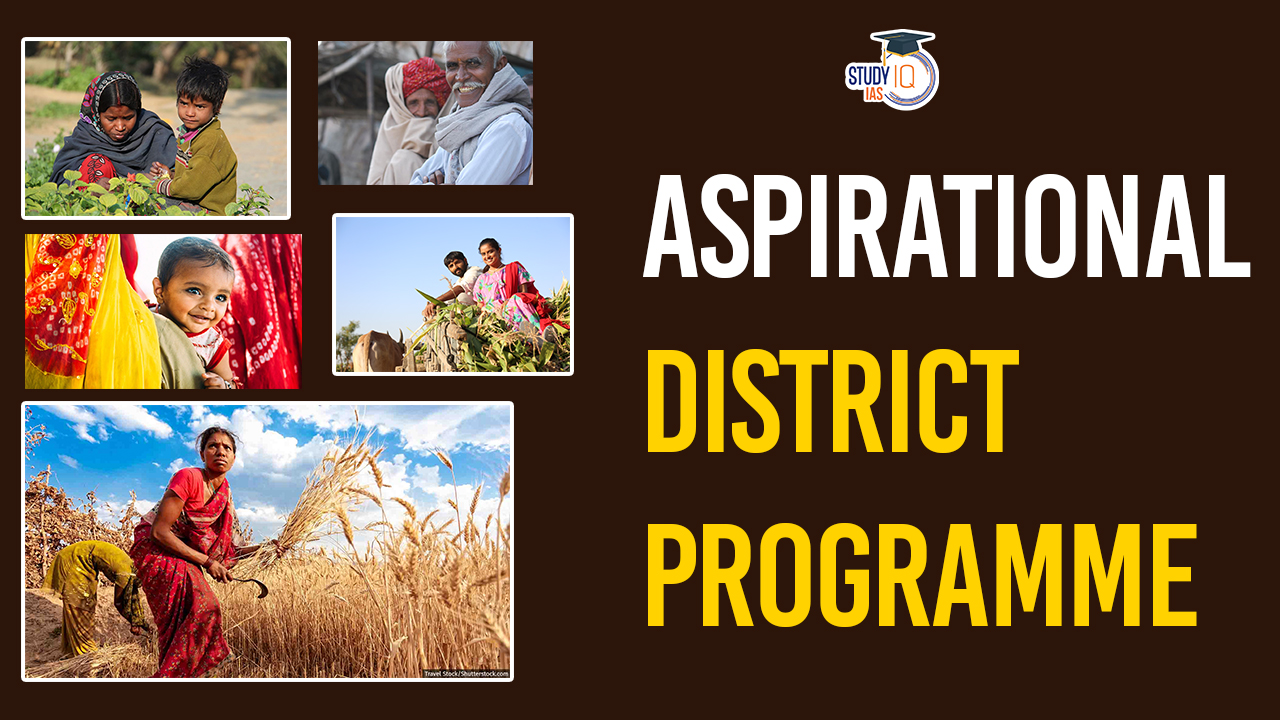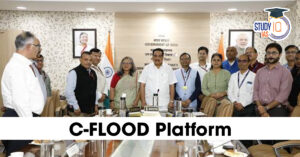Table of Contents
Aspirational District Programme
In January 2018, the Indian government launched the Aspirational Districts Programme (ADP) to transform 112 underdeveloped districts across 28 states into beacons of socio-economic progress. This initiative, spearheaded by the Prime Minister, sought to shift the development narrative from labeling these districts as ‘backward’ to ‘aspirational,’ emphasizing their potential and the collective commitment to uplift them. As we delve into the journey of the ADP, it becomes evident that while challenges persist, there are remarkable strides towards inclusive development and empowerment.
Aspirational District Programme Overview
| Aspirational Districts Programme Overview | |
| Program Launch | January 2018 |
| Scope | 112 underdeveloped districts across 28 States |
| Objectives | Improve socio-economic outcomes, shift development narrative |
| Coordination | NITI Aayog, Central Ministries, State Governments |
| Core Themes | Health & Nutrition, Education, Agriculture & Water Resources, Financial Inclusion & Skill Development, Basic Infrastructure |
| Delta Ranking | Measures improvement month-on-month through Champions of Change dashboard |
| Institutional Framework | NITI Aayog anchors program, ministries drive progress, states lead implementation |
| Core Strategy | Leverage district strengths, foster mass participation, identify low-hanging fruits, measure progress transparently, nurture culture of excellence |
| Significance | Greater autonomy, improved governance, replication of innovative approaches, enhanced collaboration, competition among districts |
| Achievements | Health and Nutrition, Education, Agriculture and Water Resources, Basic Infrastructure, Financial Inclusion and Skill Development |
| Challenges | Inadequate coverage, implementation imbalances, budgetary constraints, coordination issues, ranking methodology shortcomings |
We’re now on WhatsApp. Click to Join
Understanding the Aspirational Districts Programme
The ADP, coordinated by NITI Aayog in collaboration with Central Ministries and State Governments, focuses on five core themes: Health & Nutrition, Education, Agriculture & Water Resources, Financial Inclusion & Skill Development, and Basic Infrastructure. Each district’s progress is measured through a delta ranking system, encouraging healthy competition and accountability.
Institutional Framework and Core Strategy
NITI Aayog anchors the program at the central level, while individual ministries drive progress in respective districts. The core strategy revolves around leveraging district-specific strengths, fostering mass participation in development efforts, identifying low-hanging fruits for quick wins, measuring progress transparently, and nurturing a culture of excellence from district to national levels.
Key Features of Aspirational District Programme
The key features of the Aspirational Districts Programme include:
- Inclusive Targeting: Targets 112 underdeveloped districts across 28 states, accounting for over 20% of the country’s population and encompassing more than 8,600 gram panchayats.
- Multi-Sectoral Approach: Addresses socio-economic challenges through five core themes: Health & Nutrition, Education, Agriculture & Water Resources, Financial Inclusion & Skill Development, and Basic Infrastructure.
- Coordination Mechanism: Coordinated by NITI Aayog with support from Central Ministries and State Governments, ensuring a collaborative approach to development.
- Delta Ranking System: Measures district progress month-on-month through the Champions of Change dashboard, promoting transparency, accountability, and healthy competition among districts.
- Innovative Strategies: Focuses on leveraging district-specific strengths, fostering mass participation, identifying low-hanging fruits for quick wins, and nurturing a culture of excellence.
- Decentralization: Empowers states and districts to identify and address their unique development challenges, promoting local ownership and decision-making.
- Governance Reforms: Emphasizes improving governance, making use of existing resources more efficiently, and achieving better outcomes for the same amount of investment.
- Replication of Best Practices: Encourages replication of successful models and innovative service delivery approaches across districts, facilitating peer learning and knowledge sharing.
- Partnership and Collaboration: Facilitates collaboration between government agencies, private sector entities, philanthropic organizations, and technical partners to leverage resources and expertise for development.
- Focus on Results: Prioritizes results-oriented interventions aimed at achieving tangible improvements in key socio-economic indicators within aspirational districts.
Significance of Aspirational District Programme
- Empowerment of Marginalized Regions: The ADP aims to uplift 112 underdeveloped districts across the country, which have historically lagged behind in socio-economic indicators. By focusing resources and attention on these regions, the program seeks to empower marginalized communities and bridge the gap between developed and underdeveloped areas.
- Decentralization and Local Empowerment: Through the ADP, states and districts are granted greater autonomy in identifying their development challenges and designing customized interventions to address them. This decentralization of power ensures that local needs and priorities are adequately addressed, leading to more effective and sustainable development outcomes.
- Improved Governance and Service Delivery: The program emphasizes governance reforms and the efficient utilization of existing resources to achieve better outcomes. By promoting transparency, accountability, and innovation in service delivery, the ADP aims to enhance the quality of life for residents in aspirational districts.
- Fostering Collaboration and Partnership: The ADP encourages collaboration between government agencies, private sector entities, philanthropic organizations, and technical partners to leverage their resources and expertise for the benefit of aspirational districts. This multi-stakeholder approach enhances the effectiveness and reach of development initiatives.
- Promotion of Innovation and Best Practices: The program serves as a platform for experimenting with innovative solutions and replicating successful models across different districts. By sharing best practices and lessons learned, the ADP facilitates peer learning and accelerates progress towards development goals.
- Promoting Competition and Accountability: Through the delta ranking system and regular monitoring of progress, the ADP fosters healthy competition among districts and incentivizes them to strive for continuous improvement. This culture of competition promotes accountability and ensures that resources are utilized efficiently to achieve tangible results.
- Global Recognition and Replication: The success of the ADP has garnered recognition from international organizations like the United Nations Development Programme (UNDP), which has recommended its replication in other developing countries. This global endorsement reaffirms the program’s effectiveness and underscores its potential to drive inclusive development on a larger scale.
Achievements of the Aspirational Districts Programme
The achievements of the Aspirational Districts Programme are significant and diverse, spanning various sectors. Here’s a summary of its accomplishments:
- Health and Nutrition:
- Establishment of model Anganwadi centers for women and children.
- Increase in institutional deliveries, leading to improved maternal and child health outcomes.
- Reduction in severe acute malnutrition rates among infants.
- Introduction of the Poshan App for real-time health data analytics, aiding in monitoring and improving health services.
- Education:
- Implementation of innovative approaches such as the ‘Hamara Vidyalaya’ model in remote districts.
- Substantial improvement in learning outcomes and teaching practices.
- Digitization initiatives enhancing access to quality education.
- Reduction in dropout rates and improved school infrastructure.
- Agriculture and Water Resources:
- Emphasis on improving irrigation facilities, enhancing crop yield, and farmer education.
- Creation of market linkages for indigenous products, promoting agricultural entrepreneurship.
- Encouragement of organic farming practices, such as the cultivation of fertiliser-free organic black rice.
- Basic Infrastructure Development:
- Significant advancements in infrastructure, particularly in Left Wing Extremism (LWE) affected districts.
- Improved connectivity through the expansion of road networks.
- Enhanced access to urban areas, facilitating economic growth and development.
- Implementation of infrastructure projects to support socio-economic development.
- Financial Inclusion and Skill Development:
- Launch of Micro-ATMs to provide financial assistance, particularly to women self-help group members.
- Provision of commission-based income opportunities through financial transactions.
- Skill development initiatives aimed at enhancing employability and income generation.
Challenges of Aspirational District Programme
Despite its commendable achievements, the ADP faces challenges such as inadequate coverage, implementation imbalances, budgetary constraints, coordination issues, and shortcomings in ranking methodologies. To overcome these hurdles, there is a pressing need to strategize for indicator saturation, strengthen governance mechanisms, extend the ADP template to underdeveloped blocks, and realign sectors to include vital aspects like environment and gender.
Aspirational District Programme UPSC
The Aspirational Districts Programme stands as a testament to India’s commitment to inclusive development and equitable growth. While it continues to navigate challenges, its impact on improving the lives of citizens in marginalized regions cannot be overstated. As we chart the course ahead, it is imperative to build on the program’s successes, address its shortcomings, and foster a culture of sustainable progress for all, embodying the spirit of ‘SABKA SAATH, SABKA VIKAS.’ Through concerted efforts and collective determination, we can truly empower every aspirational district and realize the vision of a prosperous, inclusive India.


 BHARAT Initiative: Establishing Healthy ...
BHARAT Initiative: Establishing Healthy ...
 C-FLOOD Platform - A Unified Inundation ...
C-FLOOD Platform - A Unified Inundation ...
 ESIC Launches SPREE 2025 to Expand Socia...
ESIC Launches SPREE 2025 to Expand Socia...





















